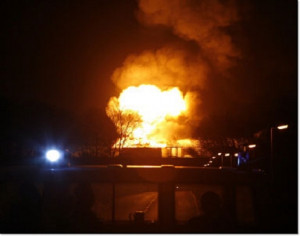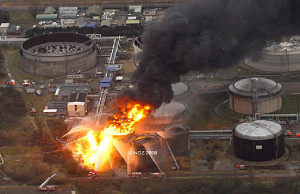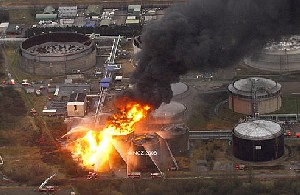During maintenance works, a leak occurred at 2:26 pm on a joint inside a blocking station located near the connection between an ethylene pipeline serving several plants and a Y-branch supplying a plastics factory.
A stationary monitoring camera recorded the incident chronology as of 2:28. The local remote-controlled hydraulic valve was closed at 2:30, though the ethylene still ignited. 2 minutes later, internal responders cooled the adjacent acrylonitrile tanks, which were made of aluminium and surrounded by a concrete enclosure. The ethylene transfer was shut down, the injection valve locked and all residual gas directed to a burner. The pressure plummeted from 83 bar to just a few mbar in 12 min, while the ethylene temperature dropped from 16°C to -30°C. 4-m high, the flame waned then became intense at 2:38, reaching the hydraulic valve 2 m from the joint. This flame resurgence stemmed from the destruction of the hydraulic liquid tank for the valve exposed to high temperature. Both the valve and bypass burned a few seconds later. Ethylene in the bypass and pipeline, pressurised at 83 bar and heated to high temperature, then decomposed in generating a significant rise in both temperature and pressure. With the bypass destroyed, the pipeline was no longer insulated. The next valve, 11 km away, had been closed 2 min prior; however, the 200 tonnes of ethylene in the intermediate pipe segment burned, forming a 30 to 40-m high flame (at 2:43), which would not be extinguished until 7:26 that evening. External responders arrived on the scene at 3 pm. Due to the domino effect, the heat flux (2,000°C) reached one of the acrylonitrile tanks at a 10-m distance; its roof, not protected by the concrete enclosure, began to melt. At 4:30, the flames attacking this tank reached heights of 16 to 20 m.
Residents were ordered to remain indoors. Given the thermal updraft, smoke rose as high as 700 m; pollutant measurements indicated that detection thresholds (2-5 ppm for NOx and 2 ppm for HCN) had not been exceeded.
The tank burned until reaching the acrylonitrile level (i.e. 6 m below the roofline). A water/acrylonitrile mix spread between the concrete sidewall and the tank, causing the concrete to crack. The tank was at risk of collapse; responders (1,180 fire-fighters) used foam to extinguish the blaze at 11:50 pm; in all, 300 tonnes of ethylene and 1,200 tonnes of acrylonitrile burned.
Both appraisals conducted pointed to an electrostatic discharge and offered recommendations on the distances to maintain between inflammable gas pipelines and inflammable liquid tanks, as well as on improving the safety of pipeline connections. The regional agency implemented an inspection programme for similar pipelines running adjacent to SEVESO sites. The eventual application of such recommendations could initiate new inspections, safety report updates and adaptations in order to satisfy these latest requirements.
Download the detailed report in .pdf format (485 Kb)






